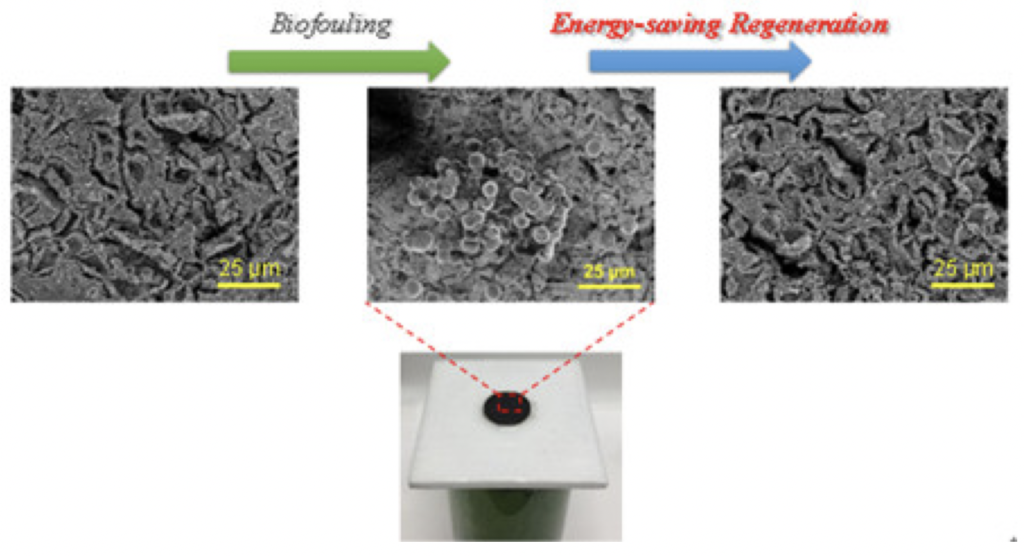CAS QIBEBT develops perovskite oxide-based porous membrane for solar-driven evaporation and regeneration
Biological pollutants such as algae, or organic pollutants cause pollution of photothermal films in solar-driven water evaporation. They can be removed by high-temperature degradation, resulting in considerable energy consumption. The group around JIANG Heqing at CAS Qingdao Institute of Bio-Energy and Environmental Biotechnology (QIBEBT) has used the catalytic and photothermal properties of cobalt-based perovskite for a multifunctional perovskite oxide porous membrane. In tests using algae and melamine as pollutants, the La0.7Sr0.3CoO3 (LSCO) porous membrane significantly reduced the combustion decomposition temperature of the pollutants attached to it, reducing the energy consumption of the porous membrane during the combustion process. Performance could be almost completely restored after multiple membrane regeneration cycles.
CAS news release, February 19, 2020

China installs digital safety system for nuclear power plants
The distributed digital control system DCS can supervise up to 200 nuclear reactors and initiate automatic shut-down in case of problems. The system was developed in China and is considered there as the safest control system hitherto developed. China at present...
CAS puts stem cell information platform into trial operation
The Chengdu Literature Information Center and the Guangzhou Institute of Biomedicine and Health, both under the Chinese Academy of Sciences (CAS), have published a website “Stem Cell Innovation Engine”, http://stemcell.kmcloud.ac.cn, which tries to...
CAS Dalian Institute of Chemical Physics transforms ABE fermentation mixture into 4-heptanone in high yield
WANG Feng and colleagues have used a typical dilute fermentation broth of Clonstridium acetobutylicum containing ABE (acetone–butanol–ethanol–water) and transformed the mixture to 4-heptanone (4-HPO), using tin-doped ceria (Sn-ceria) as a Guerbet-catalyst. Selectivity...
Climbing robot can be used for security checks and logistics
Zhejiang University has introduced a four-legged robot that can walk and climb stairs. "Shadow" can lift objects weighing 20 kilograms, is one meter long, 60 centimeters high and weighs 70 kilograms. The robot is fully electric, has a charged operating time of about...
Rhodomyrtosone B from Rose myrtle: a potential drug against MRSA
As shown by Haibo TAN and colleagues at CAS South China Botanical Garden, rhodomyrtosone B shows high antibacterial activity with a MIC of 0.62 – 1.25 µg/L against MRSA and 2.5 µg/L against vancomycin-resistant Enterococcus...
CAS Institute of Biophysics: new CRISPR-Cas complex at 3.35 Å resolution
The groups of Tao JIANG and Xiangxi WANG have solved the structure of the CRISPR-CAS complex of Thermococcus onnurineus by cryo electronmicroscopy. It is the hitherto simplest structure of such complex and might be developed into a new engineering tool. CAS news...
Group at CAS SIAT finds inexpensive black phosphorus preparation for photocatalysis
The team around YU Xuefeng at the CAS Shenzhen Institutes of Advanced Technology (SIAT) has developed a low-cost metal-free photocatalyst based on black phosphorus for effective photocatalysis. Using a simple ball-milling technique, the team converted red phosphorus...
“Beautiful China” program to be largely completed by 2035
According to the National Bureau of Forestry and Grassland, China will have created an ecological environment as a whole by 2020 and realized the targets of “beautiful China” by 2035. The forest industry should have reached the state of developed countries by 2050. By...
CAS Ningbo Institute of Materials Technology and Engineering develops a 3kW graphene-based aluminum fuel cell
The team developed a graphene-based aluminum fuel cell with an energy density of 545Wh/kg and a capacity of 130kWh. The system consists of an array of six 10-cell batteries in series. Test results show that 50A current discharge power can reach 3000W, peak power is...
China connects Tibet to ultrahigh electric power grid
The Tibet – Changchun grid connection is considered the most complicated in the world, due to severe differences in elevation. Transmission capacity is 400,000 kW, with a target on 1 million kW. Total investiment is about 16.2 billion RMB or about 2 billion €. Japan...
CAS Institute of Industrial Biotechnology achieves vitamin-B12 synthesis in E. coli using synthetic biology
The group of ZHANG Dawei divided the vitamin B12 biosynthesic pathway into six modules into which they engineered a total of 28 genes from R. capsulatus, Brucella melitensis, Sinorhizobium meliloti 320, ,S. typhimurium, and Rhodopseudomonas palustris. Each module was...
Chinese teams win top 5 places in US Face Recognition Vendor Test (FRVT)
The FRVT 2018 organized by the US National Institute of Standards and Technology (NIST) has measure advancements in the accuracy and speed of one-to-many face recognition identification algorithms searching enrolled galleries containing at least 10 million...
